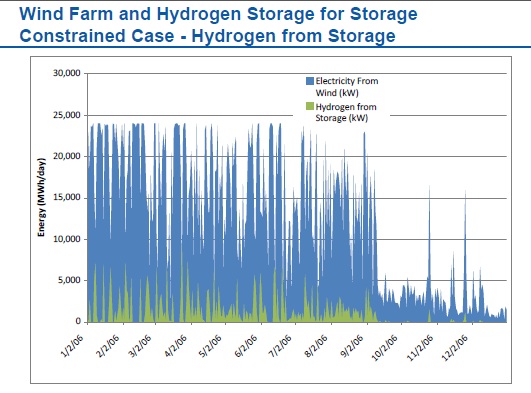Hydrogen for renewable energy storage, obtained by electrolysis of water, hasn’t gotten much play in the United States, but a novel project unfolding in Hawaii could provide some real-world insight into the viability of the technology as a grid-management tool.
A Hawaii Natural Energy Institute project in the planning stages would take advantage of clean power from the Puna Geothermal Venture, which has been operating since 1993 on the Big Island and is rated by owner Ormat at 38 megawatts. This plant — surprisingly, given the state’s famous volcanic activity, the only geothermal setup in the state — provides around 20 percent of the Big Island’s electricity.

Under the project plan, geothermal-produced electricity will be used onsite to separate hydrogen and oxygen, the process known as electrolysis. The hydrogen will then be put into 12 cylinders at 450 bar (6,600 psi), for a total of 230 pounds, and loaded onto a specially designed trailer. The trailer will be pulled to a public transit yard, where the hydrogen will be used to power a 19-passenger shuttle bus that has a 10 kilogram capacity tank.
That the project is using geothermal is incidental and the use of the hydrogen with the bus is mostly a side benefit, although Hawaii is a leader in hydrogen fuel cell vehicle promotion and the process at play here could be a factor in its growth.
But the real aim is to gain a better understanding of the electrolyzer operation, testing its performance and durability under dynamic conditions and drawing some conclusions, perhaps, about the costs and benefits of using the technology to store energy that can then be used to mitigate the grid impacts of variable renewable energy sources – solar and wind — that are booming on the islands.
According to the draft environmental assessment for the project, “The problem being experienced on the (Hawaii Electric Light Company) grid is that as the level of intermittent renewables is increased, it has become increasingly more difficult to manage the grid, which sometimes requires additional fossil fuel generation to provide the necessary grid stability support.”
On page 2: Wind is the usual candidate for electrolyzer powering
Stored hydrogen – obtained from renewable energy sources — could be used in fuel cells to replace the fossil fuel generation now used to keep the grid stable.

Wind is typically presented as the best candidate to power electrolyzer operations; we’ve seen several projects getting under way on a small scale in Germany, with the hydrogen being used in a variety of ways, including in fuel cells. In the U.S., a National Renewable Energy Laboratory presentation in 2010 [PDF] referenced testing of 10-kilowatt wind turbine powered electrolysis. The researchers concluded that by reducing the amount of electricity from wind that must be curtailed – that is, not accepted onto the grid – wind-to-hydrogen could trim the levelized cost of wind energy.
This Hawaii Natural Energy Institute project is sponsored by the Naval Research Laboratory with funding via the U.S. Department of Energy, according to the institute. The draft environmental assessment came with an “anticipated finding of no significant impact.”
A 150-page PDF of the draft environmental assessment, which came with an “anticipated finding of no significant impact” on the environment, is available online here.